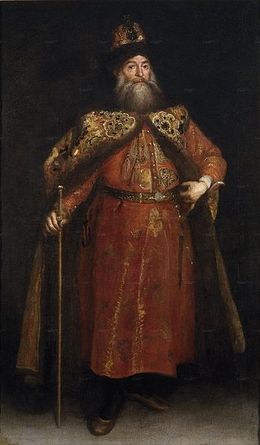Bojar
Boyar - was a member of the highest rank of the feudal Bulgarian, Moscovian, Kievan Rus'ian, Wallachian, and Moldavian aristocracies, second only to the ruling princes (in Bulgaria, tsars), from the 10th century through the 17th century. The rank has lived on as a surname in Russia and Finland, where it is spelled Pajari.
After the Mongol invasion in the 13th century, the boyars from central and southern parts of Kievan Rus' (modern Belarus and Ukraine) were incorporated into Lithuanian and Polish nobility (szlachta). In the 14th and 15th centuries, many of those Ukrainian boyars who failed to get the status of a nobleman actively participated in the formation of the Cossack army, based in the south of modern Ukraine.
In medieval Serbia, the rank of the Boyars (Serbian: Боjари, Bojari) was equivalent to the rank of the Baron; meaning "free warrior" (or "free man" in general).
Prior to the creation of the Lithuanian state by Mindaugas, lesser members of the nobility were called bajorai (singular - bajoras) and greater nobles, kunigai (singular - kunigas), from the Old German: kunig, meaning "king", or Lithuanian: kunigaikštis, usually translated as duke, Latin: dux. They evolved from tribal leaders, and were chiefly responsible for waging wars and organizing raids operations into enemy's territory. After the establishment of a unified state they gradually became subordinates to greater Dukes, and later to the King of Lithuania. After Mindaugas' death all Lithuanian rulers held the title Grand Duke (Lithuanian: Didysis kunigaikštis), or king (rex which was used in Gediminas' title).
Bojar - w średniowiecznej Bułgarii (do XIV wieku), Wołoszczyźnie, Mołdawii i później na Rusi - wyższa szlachta feudalna, magnaci, wielcy właściciele ziemscy.
W Księstwie Moskiewskim, w ramach Dumy Bojarskiej, współuczestniczyli w rządzeniu państwem. W Rosji tytuły bojarskie stosowano do czasów Piotra I Wielkiego, który je zniósł. Bojarów dzielono w średniowieczu i w XVI -XVII wieku na Bojarów Wielkich z dziedzicznym prawem do uczestniczenia w Dumie (dwie rodziny) co dawało rodzinom pozycję Diuka, wyższego rangą od księcia - np. Romanow czy przodkowie Puszkina i inne linie tej rodziny. następnie Bojarzy Wielcy - magnaci i Bojarzy tzn. szlachta wyższa.
Na terytoriach Wielkiego Księstwa Litewskiego niższa warstwa szlachty sytuująca się poniżej kniaziów i panów.
